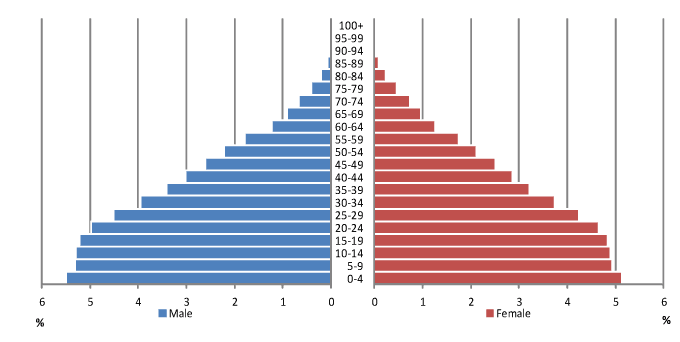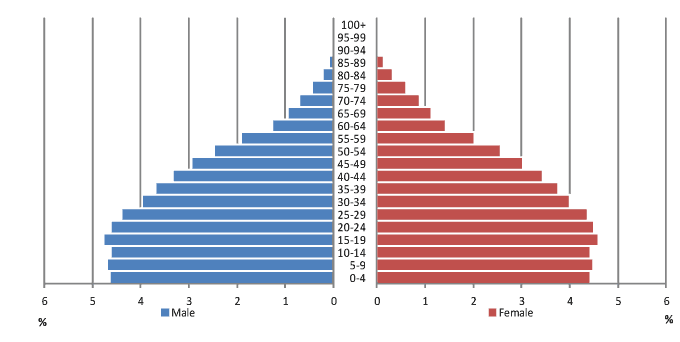Variation in age structures (cont.)
Asia
![]() Click on the tabs below to see the population pyramids for different regions within Asia.
Click on the tabs below to see the population pyramids for different regions within Asia.
Note: All years are 2010

- Proportion aged <15: 19%
- Proportion aged >65: 10%
- Median age: 35.5
- Total Dependency Ratio: 39.6
- Youth Dependency Ratio: 26.3
- Old Age Dependency Ratio: 13.3

- Proportion aged <15: 31%
- Proportion aged >65: 5%
- Median age: 24.7
- Total Dependency Ratio: 55.9
- Youth Dependency Ratio: 48.4
- Old Age Dependency Ratio: 7.5

- Proportion aged <15: 27%
- Proportion aged >65: 6%
- Median age: 27.5
- Total Dependency Ratio: 49
- Youth Dependency Ratio: 40.7
- Old Age Dependency Ratio: 8.3

- Proportion aged <15: 32%
- Proportion aged >65: 5%
- Median age: 24.9
- Total Dependency Ratio: 56.9
- Youth Dependency Ratio: 49.5
- Old Age Dependency Ratio: 7.4
Copyright information
Source information
Exercise
![]() Compare the population pyramids shown on this page. Write notes on which one stands out as different to the rest. In what way is it different? Examine the countries which are included in each region by looking at the map linked to at the top of the page. Based on this, can you think of why this region differs in the way that you have seen?
Compare the population pyramids shown on this page. Write notes on which one stands out as different to the rest. In what way is it different? Examine the countries which are included in each region by looking at the map linked to at the top of the page. Based on this, can you think of why this region differs in the way that you have seen?
Eastern Asia has a considerably different age structure, when compared to the other regions in Asia that are displayed on this page.
In particular, the population pyramid for Eastern Asia has a much smaller proportion of the population in the youngest age groups, with 19% of the population aged under 15. This can be seen in the 'undercut' in the population pyramid, as well as in the smaller youth dependency ratio. This is suggestive of a recent and considerable decline in fertility.
The provided map shows that one of the countries included in the Eastern Asia region is China. Due to the size of China’s population, the population pyramid for the region is almost entirely shaped by this one country. Because of this we can suggest that the considerable decline in fertility in recent decades may be due to China’s One-Child Policy, which restricted the majority of couples to a single child.
In particular, the population pyramid for Eastern Asia has a much smaller proportion of the population in the youngest age groups, with 19% of the population aged under 15. This can be seen in the 'undercut' in the population pyramid, as well as in the smaller youth dependency ratio. This is suggestive of a recent and considerable decline in fertility.
The provided map shows that one of the countries included in the Eastern Asia region is China. Due to the size of China’s population, the population pyramid for the region is almost entirely shaped by this one country. Because of this we can suggest that the considerable decline in fertility in recent decades may be due to China’s One-Child Policy, which restricted the majority of couples to a single child.